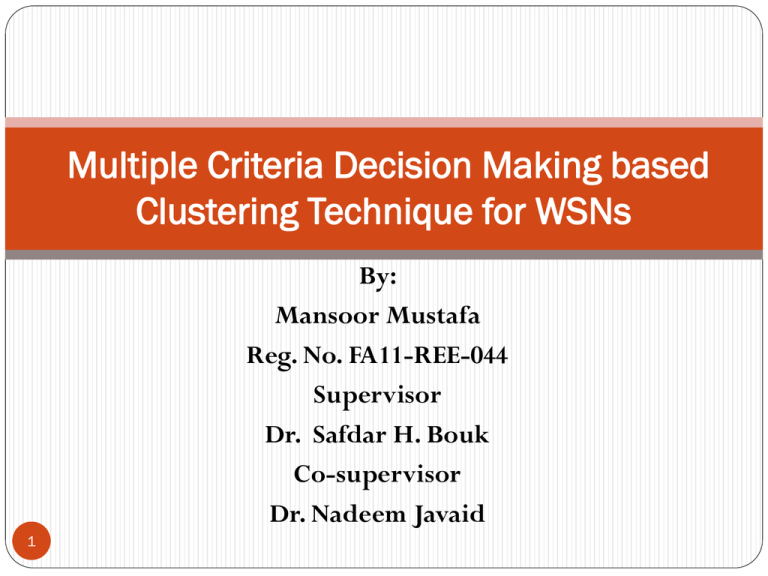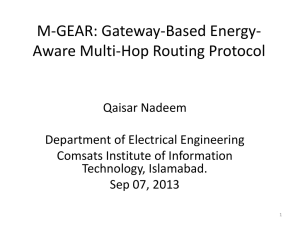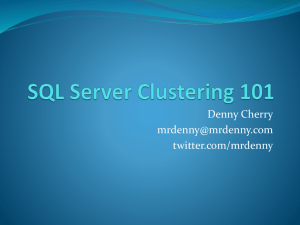TP - Nadeem Javaid
advertisement

Multiple Criteria Decision Making based Clustering Technique for WSNs By: Mansoor Mustafa Reg. No. FA11-REE-044 Supervisor Dr. Safdar H. Bouk Co-supervisor Dr. Nadeem Javaid 1 Outline Introduction to WSNs Compression with traditional Networks WSN Challenges Introduction to Clustering Previous Work Problem Statement Proposed Scheme Research Methodology Simulation and Results Conclusion 2 Wireless Sensor Networks Composed of a large number of sensor nodes. Are densely deployed either inside the phenomenon or very close to it. Random deployment 3 Comparison of WSNs with traditional Networks 4 Traditional Networks Wireless Sensor Networks General-purpose design; serving many applications Single-purpose design; serving one specific application Typical primary design concerns are network performance and latencies; energy is not a primary concern Energy is the main constraint in the design of all node and network components Networks are designed and engineered according to plans Deployment, network structure, and resource use are often ad-hoc (without planning) Devices and networks operate in controlled and mild environments Sensor networks often operate in environments with harsh conditions Maintenance and repair are common and networks are typically easy to access Physical access to sensor nodes is often difficult or even impossible Component failure is addressed through maintenance and repair Component failure is expected and addressed in the design of the network Obtaining global network knowledge is typically feasible and centralized management is possible Most decisions are made localized without the support of a central manager WSN Challenges Energy Security Self-Management Wireless Networks Design Constrains Energy is the major challenge in WSNs Different MAC and Routing protocols are designed to minimize energy consumption Clustering is most energy efficient routing technique in WSNS 5 Introduction to Clustering Important method for prolonging network lifetime in WSNs Divides WSN into groups, called Clusters, and in each Cluster a Head/Leader/Manager node, called Cluster Head (CH), is assigned by Sink/selected by consensus from Group. CHs collect data from respective cluster members and forward aggregated data to the Sink/Base Station (BS). 6 Flat v/s Hierarchical/Clustered Architecture 7 Flat Architecture Hierarchical/Clustered Architecture Previous Work LEACH: which was the very first clustering protocol for WSN. In LEACH, homogeneous sensor nodes (i.e. having same initial energy) are considered In each round, CH responsibility is rotated among high energy nodes in order to balance the communication load among all nodes LEACH operates in two phases: Advertising phase Data transmission phase 8 Previous Work ….. Stable Election Protocol (SEP) protocol assumes that in real 9 environment nodes have different energy. SEP divides heterogeneous nodes energy environment in two types of nodes, i.e., advance nodes and normal nodes Advance nodes have some amount of more energy than normal nodes SEP assign a weighted probability to each node based on its energy SEP improves the cluster formation of LEACH by decreasing the CH epoch interval of advance nodes, i.e., advance nodes get more chances of becoming CH. Problem Statement Problems with single criteria: Mostly based on residual energy. Don’t consider other information, like location of nodes, number 10 of neighbor nodes etc So normal nodes consumes more energy to send their data to CHs. Problems with Centralized: Increased processing over head. Results in shorter lifetime of nodes Problems with single hop communication: Data from nodes away form CHs/base station have to travel longer distance as compared to nearer nodes, hence they die earlier. Proposed Scheme A major challenge in WSNs is selection of appropriate cluster head Selection of CH largely affects WSNs lifetime. Ideal cluster head is one which is selected on multiple criteria. We propose a distributed CH selection technique based on Multiple-Criteria Decision Making (MCDM) We use Fuzzy-TOPSIS method of MCDM We consider four criteria: residual energy, number of neighbors, distance form BS and average distance form neighbors. 11 MCDM and Fuzzy-TOPSIS MCDM methods are used to solve the decision making problems in field of engineering and sciences, with multiple attributes. They compare and rank multiple alternatives based on degree of desirability of their respective attributes. Technique for Preference by similarity to Ideal Solution (Fuzzy-TOPSIS) consists of decision matrix with’m’ number of a alternatives and ’n’ number of attributes for each alternative. It uses relative importance of attributes instead of using precise values. 12 Research Methodology…. Proposed Scheme is based on four phases Phase1: Network Deployment: Nodes are deployed randomly and uniformly Nodes are fixed Homogenous Base Station is capable of receiving, aggregating, and then forwarding the data from the cluster heads to the desired destinations. 13 14 Network Deployment Research Methodology….. Phase 2: Neighbor Discovery: Initially, all nodes broadcast a Hello packet, which contains 15 node’s ID, location information and four criteria values. Residual Energy, C1, Node Density C2, Distance to the BS, C3, Average Distance between this node and its neighbors, C4. Initially, C2 and C4 fields in the Hello packet will be empty After sharing Node ID and location information with its neighbors, each node can easily compute C2 and C4. Exchange it in the next Hello packet Research Methodology…. All the other nodes in the transmission range Tr of that node, receive Hello packet. After receiving hello packet from all neighbors, a node updates its neighborhood table (T) with neighboring node’s ID, C1, C2, C3, C4 as well as its own information For n neighbors of node k, then Tk will be: 16 Research Methodology….. Phase 3: CH selection and Cluster Formation: CH selection based on MCDM Criteria must be normalized to the similar range [0 − 1] to fairly select a CH C1 and C2 are Positive Ideal Solutions (PIS) C3 and C4 are Negative Ideal Solutions (NIS) PIS NIS 17 After Normalization the preference or weight ’wi’ are assigned to each criterion. These, weights are application specific. For our proposed scheme: Fuzzy membership function is used to categorize these normalized value of each criteria and their respective weights for every node. 18 After that, PIS and NIS are determined from Vk matrix Determine separation measure: 19 Finally calculate Rank Index (R.I) The node with highest value in this rank index of all nodes within its transmission range (neighbors) announces itself as CH in that region. Other nodes in that region, send join request to associate with the CH and act as member nodes The CH acknowledges to all of its members 20 21 Procedure for CH change Phase 4: Communication The multi-hoping communication model is considered In intra-cluster, nodes within five meters range of CH, send their data directly to CH Other nodes perform multi-hoping with other nodes coming in their way to communicate with the CH. In inter-cluster, the CHs within twenty meters range of BS, communicates directly to BS remaining CHs perform multihoping via other CHs. 22 Research Methodology 23 24 Simulation and Results Simulation Parameters: 25 Results: Network Stability 26 Results: Network Lifetime 27 Results: Network Energy Consumption 28 Results: CH Stability Ratio 29 Results: Network Control Overhead 30 Results: Network Throughput 31 Conclusion Simulation results show that multiple normalized criteria for CH selection improves throughput, consumes less energy, minimum variations in CH re-elections (cluster stability), network lifetime, and very less control overhead, compared to the previous clustering schemes. 32 Publications M. Mustafa, T. Shah, Safdar H. Bouk, Syed H. Ahmed and N. Javaid, “Distributed Multiple Criteria based Clustering Scheme for Wireless Sensor Networks”, accepted in IEEE Vehicular Technology Society Asia Pacific Wireless Communications Symposium 2013 A. Rehman, M. Mustafa, I. Israr, M. M. Yaqoob, “Survey of Wearable Sensors with Comparative Study of Noise Reduction ECG Filters”, International Journal of Computing and Network Technology (IJCNT), Vol 1, Issue 1, ISSN. 2210-1519 (Print), January, 2013, PP. 61-82 A. Rehman, M. Mustafa, N. Javaid, U. Qasim, Zahoor Ali Khan, “Analytical Survey of Wearable Sensors”, Seventh International Conference on Broadband and Wireless Computing, Communication and Applications (BWCCA), 2012, BioSPAN-12, Proceedings of IEEE M. M. Yaqoob, I. Israr, M. Mustafa, A. Rehman, “Evaluation and Analysis of 33 IEEE 802.15.4 ZigBee Multi-hop Transmission in Wireless Body Area”, International Journal of Information Technology and Electrical Engineering (ITEE), Vol 2, Issue 1, ISSN. 2311-708X, March, 2013, PP. 33-37





